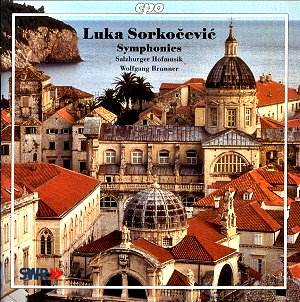Natural
disasters have often seriously damaged or even almost destroyed
the cultural heritage of countries and cities. One of the best-known
examples is the 1755 earthquake that devastated the royal palace
in Lisbon, which contained a huge collection of music from the
16th and 17th century. Other cities had their fair share of disasters
as well. One of them is the Croatian city of Dubrovnik. It experienced
a ‘golden age’ during the 17th century, but the earthquake of
1667 and the fire which followed not only killed about half of
the population but also destroyed many of its monuments. After
that Dubrovnik was rebuilt and expanded until the middle of the
18th century. The Sorkočević family - whose property
didn’t suffer any damage in the earthquake - played an important
role in the city. Several members of the family were members of
the Dubrovnik senate.
Luka
Sorkočević received an extensive education. His music
teacher was the Italian composer Giuseppe Valentini, who was maestro
di cappella in Dubrovnik Cathedral in the 1750s. Later on Sorkočević
fulfilled several posts in various branches of politics and society.
During his relatively short stay in Vienna as ambassador to the
imperial court he met several of the leading composers of his
time, like Gluck and Haydn, and the famous poet Metastasio.
His
musical output isn’t very large and consists mainly of instrumental
works, which are collected on this CD. Only some pieces have been
left out which are extant in such a rudimentary form that they
could only have been reconstructed with major additions.
These
instrumental works belong to the transitional period between baroque
and classicism. They can neither be associated with the ‘empfindsamer
Stil’ – of which the fact that they are exclusively written in
major keys is an indication – nor with the modernism of the Mannheim
school. Nevertheless, Sorkočević’ music contains traces
of both styles.
The
‘largo’ of the Symphony nr 7 shows the kind of expression which
is associated with the ‘Empfindsamkeit’ and the first movement
of the Symphony no. 1 contains the crescendi for which the Mannheim
school was famous.
On
the whole these are nice, delightful works, which I have listened
to with great pleasure. They deliver more entertainment than deep
thoughts, but what is wrong with that?
The
performance of the orchestral works is very convincing and satisfying.
Only the slow movements, in particular the ‘largo’ from the Symphony
no. 7 which was mentioned before, could have been played with
a little more feeling. And the Sonata for violin and basso continuo
is far too bland and down-to-earth.
There
is every reason to be grateful to the performers and the record
company for their imagination in recording this music. And let
us not forget the musicologist Vjera Katilinić, who has prepared
the scores and has written the excellent programme notes in the
booklet.
Johan
van Veen
